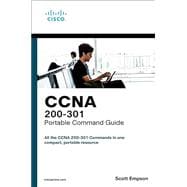- Network Fundamentals: IPv4 addressing, subnetting, VLSM, route summarization, IPv6 addressing, cables/connections, CLI
- LAN Switching Technologies: Switch configuration, VLANs, VLAN trunking protocol, inter-VLAN communication, STP, EtherChannel, CDP, LLDP
- Routing Technologies: Router configuration, static routing, OSPF
- IP Services: DHCP, NAT, NTP
- Security Fundamentals: Layer 2 security, ACL traffic management, device monitoring and hardening
- Wireless Technologies: Configuring and securing a WLAN AP
- Logical how-to topic groupings for a one-stop resource
- Great for review before CCNA certification exams
- Compact size makes it easy to carry with you wherever you go
- “Create Your Own Journal” section with blank, lined pages enables you to personalize the book for your needs










